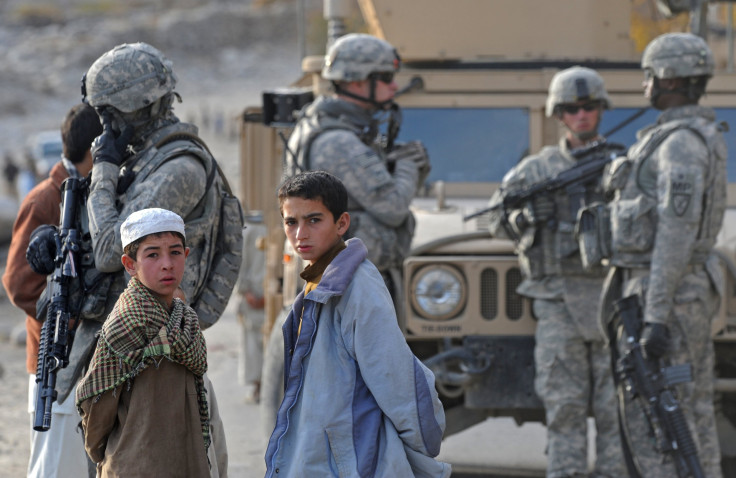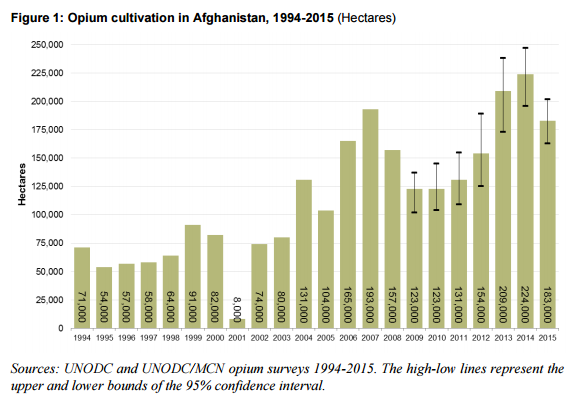Why Is The US In Afghanistan Today? A Look At Bush's Promises 15 Years Later

On the night of Oct. 7, 2001, a group of U.S. Air Force B-1 and B-52 bombers swooped over Afghanistan, attacking 31 targets, described by then-President George W. Bush as “al-Qaeda terrorist training camps and military installations of the Taliban regime.”
The Taliban, recognized by Saudi Arabia and neighboring Pakistan as the country’s legitimate rulers, imposed strict laws and punishments—such as stoning to death and amputations—but offered some stability years of far more radical and violent mujahideen control. But, after the U.S. accused the Taliban of sheltering Osama bin Laden, the architect behind the Sept. 11, 2001 terrorist attacks, the group became a public enemy of the Bush administration.
Fifteen years after Bush announced Operation Enduring Freedom, here’s a look at Afghanistan’s current reality, compared with the former commander-in-chief’s objectives:
“By destroying camps and disrupting communications, we will make it more difficult for the [Taliban] terror network to train new recruits and coordinate their evil plans. ”
While the initial two months of the invasion saw the capture of key cities Mazar-e-Sharif, Kandahar and the capital Kabul, and the United States’ declaration of victory against the Taliban, today the militant group is ever-present.
“The Taliban now controls more territory than at any time since 2001,” the Special Inspector General for Afghanistan Reconstruction said in a January report.
Aside from the group’s oppressive rule over its occupied areas, the Taliban propagates and enriches itself on the nation’s opium trade for income, pushing Afghanistan’s production to surpass that of the “Golden Triangle” formed by Laos, Thailand and Myanmar in 2007. Since the invasion in 2001, a year in which opium production in the country fell to a low of 8,000 hectares—from 82,000 the year before—the total rose to more than 200,000 hectares in 2013 and 2014 before falling slightly to around 180,000 last year, according to United Nations data.

“At the same time, the oppressed people of Afghanistan will know the generosity of America and our allies.”
As of August 2016, the U.S. war in Afghanistan has resulted in the deaths of 104,000 people, 31,000 of which were Afghan civilians, according to Brown University’s Watson Institute of International and Public Affairs in Rhode Island. Since 2001, 41,000 Afghan civilians suffered injuries related to the conflict.
A string of incidents between U.S. military and Afghan citizens in early 2012 attracted widespread criticism of and hostility to U.S. forces in the country. In January 2012, a video surfaced of two U.S. Marines in full combat gear urinating on Taliban corpses. In February of the same year, two U.S. troops were killed as hundreds of Afghans violently protested the burning of religious materials by the American military. While Obama issued an apology and promised “to avoid any recurrence,” the Taliban called for attacks on North Atlantic Treaty Organization (NATO) bases and military personnel.
Less than a month later, an American soldier left a combat outpost in the early morning hours for a town known to be sympathetic to the Taliban, and opened fire on several families, killing 16 people—nine of which were children.
“We did not ask for this mission, but we will fulfill it. ”
Whether the U.S. did or did not “ask” for this mission is a subject of hotly contested debate. But whether American troops were able to “fulfill it” is less disputed.
The U.S. spent $17 billion on the war in Afghanistan as of December 2015, ProPublica reported. Even as the Obama administration has reduced the number of troops from 100,000 to 8,500 over the past several years, the idea of an American victory has becoming increasingly dubious.
“Ground realities make it hard for the Afghan people to swallow the idea that U.S. troops are present to continue the fight against terrorism in Afghanistan,” wrote Afghan journalist Aimal Faizi for Al Jazeera. “It is the growing strength of the foreign-backed terrorist groups and the failure of U.S. military strategies to counter them that further supports the notion that there will be no military solution to the war in Afghanistan. ”
“In the months ahead, our patience will be one of our strengths […] patience and understanding that it will take time to achieve our goals, patience in all the sacrifices that may come. ”
While many people, in the U.S. and Afghanistan, have eagerly awaited the end of U.S. involvement in the country, another group has long awaited the chance to peacefully return to their homeland.
Over the summer, half a million Afghan refugees, some of whom have lived in camps in Pakistan since fleeing the Soviet invasion of the 1970s, began heading back into the war-torn country with minimal aid.
Facing strong anti-refugee sentiment in Pakistan, many of the 2.5 Afghan million refugees in Pakistan felt they had no other choice but to stop waiting for conditions in their home country to improve.
“We spent three decades there, but we were pushed out in a very bad way,” one refugee told The Guardian. “You can imagine how we feel.”
“The battle is now joined on many fronts. We will not waiver, we will not tire, we will not falter, and we will not fail. Peace and freedom will prevail. ”
Perhaps in another 15 years. But for now, Afghans and Americans alike might beg to differ.
© Copyright IBTimes 2024. All rights reserved.






















